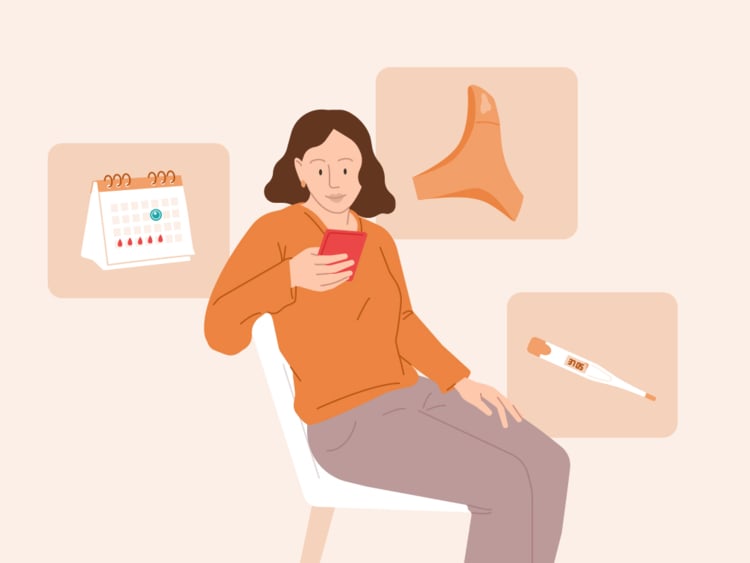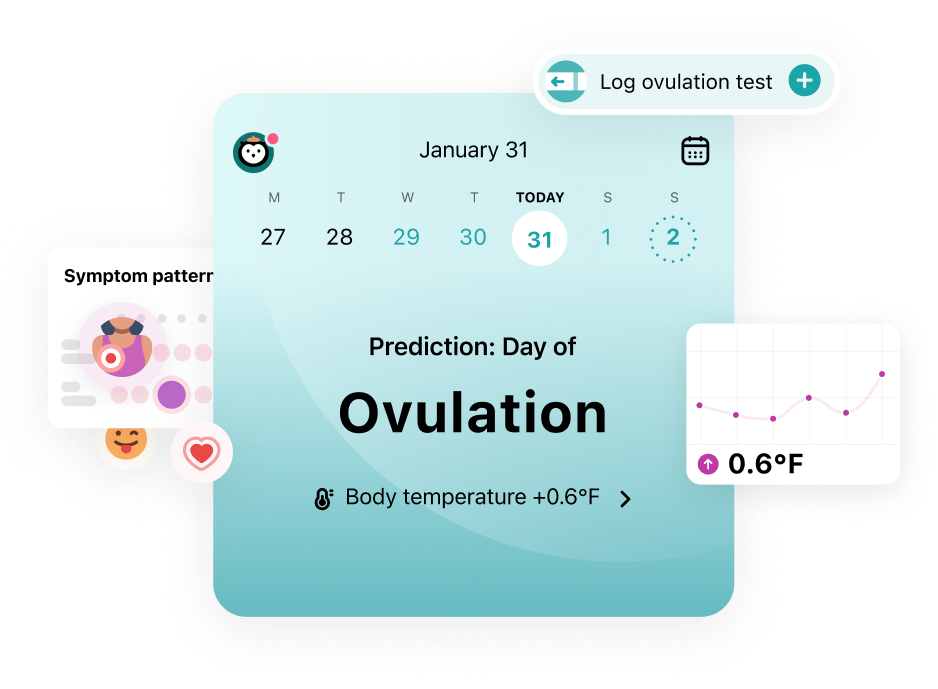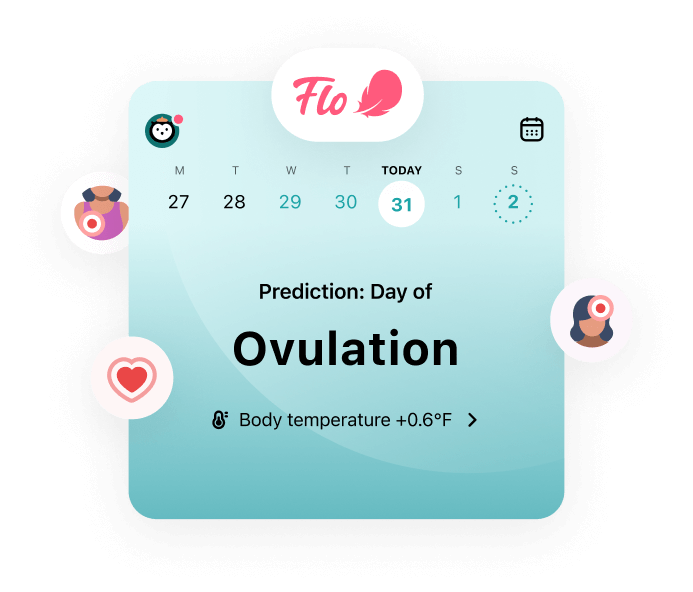Is it really safe to have unprotected sex on certain days in your cycle? Get the lowdown on the fertility awareness method with advice from a Flo expert.
-
Tracking cycle
-
Getting pregnant
-
Pregnancy
-
Help Center
-
Flo for Partners
-
Anonymous Mode
-
Flo app reviews
-
Flo Premium New
-
Secret Chats New
-
Symptom Checker New
-
Your cycle
-
Health 360°
-
Getting pregnant
-
Pregnancy
-
Being a mom
-
LGBTQ+
-
Quizzes
-
Ovulation calculator
-
hCG calculator
-
Pregnancy test calculator
-
Menstrual cycle calculator
-
Period calculator
-
Implantation calculator
-
Pregnancy weeks to months calculator
-
Pregnancy due date calculator
-
IVF and FET due date calculator
-
Due date calculator by ultrasound
-
Medical Affairs
-
Science & Research
-
Pass It On Project New
-
Privacy Portal
-
Press Center
-
Flo Accuracy
-
Careers
-
Contact Us
Fertility awareness method: How does it work, and is it effective?


Every piece of content at Flo Health adheres to the highest editorial standards for language, style, and medical accuracy. To learn what we do to deliver the best health and lifestyle insights to you, check out our content review principles.
There are so many benefits to getting to know your cycle and fertile days. It can help you predict when your period will arrive and help you better understand any changes in your mood or the way you’re feeling. If you’re trying to get pregnant, knowing when your fertile window is can give you some guidance on when it’s best to have conception sex.
Some people use the fertility awareness method to prevent pregnancy. But does it work? Here, we’ll explore everything you need to know.
Key takeaways
- The fertility awareness method is when you track your most fertile days during your cycle and avoid having unprotected sex during that time frame. It isn’t considered to be a highly effective method of contraception.
- If you don’t want to become pregnant, the best thing to do is to use a method of birth control like the copper IUD or condoms (if you’d like to avoid hormones) or hormonal methods like the pill, implant, or hormonal IUD.
- If you are trying for a baby, the fertility awareness method can help you figure out when your most fertile days are and increase your chances of getting pregnant. However, the aim on those days will be to have unprotected sex, not avoid it.
What is the fertility awareness method?
The fertility awareness method is simply learning when you are fertile during your menstrual cycle. Some people use the information to prevent pregnancy by avoiding sex (or using a barrier method of birth control) on their fertile days. This is sometimes called natural family planning. For others who are trying to have a baby, it helps them figure out when they can maximize their chances of conceiving.
So why is it that you’re fertile on some of your cycle days and not others? Well, to get pregnant, sperm needs to meet one of your eggs. So, the timing of when you release an egg from an ovary each month — also known as ovulation — is super important.
Ovulation tends to happen midway through your cycle, which would be around day 14 if your cycle lasts 28 days. Once you’ve released an egg, it remains viable for up to 24 hours — this is when it could get fertilized by a sperm.
However, because sperm can live inside your body for up to five days, the time period when you have the highest chance of getting pregnant (i.e., your fertile window) includes the five days before ovulation and one day after.
Signs to look out for
The fertility awareness method isn’t a single method of contraception but describes a few different ways that you can get to know when your most fertile days are. They include:
Calendar and standard days methods
These methods predict your fertile window based on your previous cycle lengths. So say your three previous cycles were 28 days long, then you would likely ovulate around the midpoint or day 14.
Cervical mucus method
This method involves tracking changes in your vaginal discharge, which becomes wet and slippery around the time of ovulation. Some people describe it as looking and feeling like egg whites. Then, at other points in your cycle, it can appear drier or thicker.

 Over
7.8M
ratings averaging
4.8/5
*
Over
7.8M
ratings averaging
4.8/5
*
Understand your fertility better with the Flo app
- Learn more about your fertility signals
- Improve ovulation predictions by tracking temperature via Apple Watch
- Log your ovulation test results
 Over
7.8M
ratings averaging
4.8/5
*
Over
7.8M
ratings averaging
4.8/5
*

Trying to conceive?
The Flo app can help you better understand your fertility

 Over
7.8M
ratings averaging
4.8/5
*
Over
7.8M
ratings averaging
4.8/5
*
Understand your fertility better with the Flo app
- Learn more about your fertility signals
- Improve ovulation predictions by tracking temperature via Apple Watch
- Log your ovulation test results
Take a quiz
Find out what you can do with our Health Assistant
Basal body temperature (BBT) method
After you have ovulated, your basal body temperature will rise very slightly. This is your body temperature when you’re resting. Taking your temperature at the same time every day with a precise thermometer can help you predict when you’ll ovulate.
Symptothermal method
The symptothermal method is when you use a combination of fertility awareness methods together, such as BBT and cervical mucus tracking, and a cycle calendar.
Is fertility awareness an effective form of contraception?
“In general, the fertility awareness method is considered less effective than most other types of birth control,” says Flo expert Dr. Jenna Beckham, obstetrician, gynecologist, and complex family planning specialist, WakeMed Health and Hospitals, Planned Parenthood South Atlantic, North Carolina, US. “It involves more work and has more room for human error than some other methods.”
In fact, the fertility awareness method has a perfect use failure rate of 1% to 5%, which means that between one and five people in every 100 will get pregnant in a year even if they’re using the method perfectly. With typical use — which means sometimes using the method incorrectly or inconsistently — the failure rate rises to the range of 12% to 24%. That means up to 24 people in every 100 will typically get pregnant after using the method for a year.
It can be useful to compare these stats with other methods of birth control to get some context. The implant, for example, is one of the most effective methods of birth control, with a perfect and typical use failure rate of just 0.1%. The pill, meanwhile, has a perfect use failure rate of 0.3% and a typical use failure rate of 7%.
Nonhormonal birth control is also more effective than the fertility awareness method. For example, condoms have a perfect use failure rate of 2% and a typical use failure rate of 13%. They also protect you from sexually transmitted infections (STIs). So, if you’re not planning on getting pregnant any time soon, the best thing to do is to start using a form of birth control. You can speak to your health care provider about the different options available to you.
Advantages
When it comes to birth control, there’s no one-size-fits-all option. Something that suits you may not work for your friends or family members, so it’s good to consider all of the pros and cons of each option. One of the main benefits of the fertility awareness method is its very low cost. You may need to buy a thermometer to measure your BBT, but beyond that, there are no additional costs. You might also like that:
- You don’t have to take medication, avoiding any unwanted side effects of birth control.
- You don’t have to use any devices like your phone if you don’t want to. You can use the cycle-tracking calendar method by using a pen and paper.

Disadvantages
The key downside of the fertility awareness method is its effectiveness or that it is “prone to human error or oversight,” according to Dr. Beckham. Other downsides are:
- It offers no protection against STIs. Condoms are the only method of birth control that can protect you from catching one.
- It relies on the cooperation of your partner. Both you and your partner need to agree that you won’t have sex on the days when you’re most fertile.
How does the fertility awareness method work?
There are different reasons or situations when you might consider the fertility awareness method. While it isn’t an effective way of preventing pregnancy, it can be incredibly helpful if you are trying for a baby. “Monitoring signs of fertility and having intercourse during the fertile time period can increase an individual’s chances of conceiving,” says Dr. Beckham.
So, let’s look at how the fertility awareness methods work in practice when you’re trying to conceive.
Calendar method
Sometimes called the rhythm method, the calendar method involves following these simple steps:
- Record the lengths of your most recent six to 12 menstrual cycles. You can do this by using a cycle tracker, such as Flo.
- Subtract 18 from the total number of days in your shortest cycle. This number represents your first fertile cycle day.
- Subtract 11 from the total number of days in your longest menstrual cycle. This number represents the last fertile cycle day.
- Aim to have regular unprotected sex in the period between these two fertile cycle days each month to maximize your chances of getting pregnant.
A common variation on the calendar method that requires less math is the standard days method. If your cycles are regular and usually between 26 and 32 days long, this method says your fertile days will be between days eight and 19. You can also use an app like Flo, so you don’t have to figure out the math.
Cervical mucus monitoring
Since your discharge could indicate where you’re at in your cycle and when you’re most fertile, it can be good to know what sort of consistency to look out for. Your cervical mucus becomes wet and slippery like raw egg whites. Here’s how to monitor the changes.
- Every day, check what your cervical mucus looks and feels like. You can do this by checking the discharge in your underwear or by wiping it with toilet paper. Alternatively, you can put a clean finger into your vagina to check the mucus that way and then press two fingers together to see if the mucus stretches.
- Take note of the amount, texture, and color of the discharge each day by using a calendar, notepad, or a cycle-tracking app like Flo.
- If the discharge is sticky or dry, you’re probably not in your fertile window yet. If it’s wet, slippery, or soaking your underwear, you might be.
- The egg white discharge will last for around four days. These are the days you want to have sex to maximize your chances of conceiving.
Basal body temperature tracking
Your BBT is your temperature when your body is completely at rest. Here’s how to track it when you’re trying to get pregnant.
- Using a thermometer that is specific enough to provide you with two decimals, take your temperature every morning before getting out of bed. Try to take it at the same time every day and after at least three hours of uninterrupted sleep.
- Record your temperature readings on paper or in an app like Flo.
- When you ovulate, your BBT may increase very slightly, by about 0.5°F to 1°F. Over a period of a few months, you may see patterns emerge in your readings and get an idea of the day that you tend to ovulate.
- As sperm can live inside your body for five days, you could get pregnant if you have sex from five days before ovulation until up to 24 hours after ovulation. This time period is your fertile window.
How to track ovulation more effectively
You can log your BBT, cervical mucus changes, and other ovulation symptoms in the Flo app, keeping all that important information in one place. The Flo algorithm can also predict your fertile days based on your previous cycle lengths, allowing you to try out the calendar method without having to do any of the math. All this can help you understand your body better, have sex within your fertile window, and increase your chances of getting pregnant.
Who should use the fertility awareness method?
“The fertility awareness method is one of several options for contraception,” says Dr. Beckham. “I wouldn’t say it isn’t a reliable way; it is just less effective than other methods. Ultimately, it is an individual’s choice what type of pregnancy prevention method they use.”
According to Dr. Beckham, the fertility awareness method is best suited to “individuals who are committed to learning about their menstrual cycles and who have the time and ability to carefully track the information needed to do this method successfully.”
She adds: “It can be more effective if an individual (and ideally a couple) work with a health care provider and have the time and discipline to check for fertility signs every day.”
So, are there any times when you should avoid it? “Fertility awareness methods require diligent tracking of the menstrual cycle, so if your bleeding patterns are irregular, then the tracking, and therefore detection of ovulation, is less likely to be accurate,” says Dr. Beckham. She says that this may apply if you:
- Are approaching menopause. When you are perimenopausal, your periods can become increasingly irregular.
- Have just recently started having periods
- Have recently stopped using hormonal birth control or other medications that can affect the signs of fertility
- Were pregnant recently
- Have irregular cycles, especially with bleeding or spotting between periods. (This can make it harder to identify a true period and/or assess cervical mucus.)
As other forms of contraception are more effective than the fertility awareness method, starting birth control might bring you greater peace of mind. After all, if you don’t want a baby, a pregnancy scare can be really anxiety-inducing. If you’re not sure which type of contraception is for you, check out our guide to choosing birth control. However, if you are trying for a baby, the fertility awareness method can be an excellent way to get to know your body better and boost your chances of conceiving.
FAQs
What are the safe days for not getting pregnant?
There aren’t really “safe days.” It’s true that you’re most likely to get pregnant if you have sex in the five days before one of your ovaries releases an egg or the day after. These six days are known as your fertile window. But there’s a small chance that you can become pregnant at any point in your cycle. So, if you don’t want to conceive, it’s really important to use birth control whenever you have sex.
What’s the most accurate fertility awareness method?
While it can help you get to know your body and your cycle, there’s no approach to fertility awareness that’s completely effective for avoiding pregnancy. That’s why doctors recommend using birth control if you don’t want to get pregnant.
If you’re trying for a baby, then you could try a combination of the calendar method along with tracking your basal body temperature and cervical mucus for changes. This can help you figure out where you are in your cycle and when to have sex to get pregnant.
Does the fertility awareness method prevent STIs?
No, it doesn’t. The only type of contraception that can prevent you from catching a sexually transmitted infection or disease is condoms.


Hey, I'm Anique
I started using Flo app to track my period and ovulation because we wanted to have a baby.


The Flo app helped me learn about my body and spot ovulation signs during our conception journey.


I vividly
remember the day
that we switched
Flo into
Pregnancy Mode — it was
such a special
moment.
Real stories, real results
Learn how the Flo app became an amazing cheerleader for us on our conception journey.
References
“Basal Body Temperature for Natural Family Planning.” Mayo Clinic, 10 Feb. 2023, www.mayoclinic.org/tests-procedures/basal-body-temperature/about/pac-20393026.
“Cervical Mucus.” Cleveland Clinic, my.clevelandclinic.org/health/body/21957-cervical-mucus. Accessed 28 May 2024.
“Choose the Right Birth Control.” Office of Disease Prevention and Health Promotion, 28 May 2024, health.gov/myhealthfinder/healthy-living/sexual-health/choose-right-birth-control.
“Condoms.” Cleveland Clinic, my.clevelandclinic.org/health/treatments/9404-condoms. Accessed 28 May 2024.
Greenberg, Grant M. “Is Natural Family Planning a Highly Effective Method of Birth Control? No: Natural Family Planning Methods Are Overrated.” American Family Physician, vol. 86, no. 10, 15 Nov. 2012, www.aafp.org/pubs/afp/issues/2012/1115/od2.html.
“How to Get Pregnant.” Mayo Clinic, 11 Dec. 2021, www.mayoclinic.org/healthy-lifestyle/getting-pregnant/in-depth/how-to-get-pregnant/art-20047611.
Jensen, Ashley, and Jane Wrede. “Fertility Awareness-Based Methods for Family Planning: A Literature Review.” Journal of Christian Nursing, vol. 37, no. 4, Oct./Dec. 2020, pp. 212–220, DOI: 10.1097/CNJ.0000000000000758.
“Ovulation.” Cleveland Clinic, my.clevelandclinic.org/health/articles/23439-ovulation. Accessed 28 May 2024.
“Perimenopause.” Mayo Clinic, 25 May 2023, www.mayoclinic.org/diseases-conditions/perimenopause/symptoms-causes/syc-20354666.
“Rhythm Method for Natural Family Planning.” Mayo Clinic, 7 Mar. 2023, www.mayoclinic.org/tests-procedures/rhythm-method/about/pac-20390918.
Witt, Barry. “Trying to Get Pregnant? Here’s When to Have Sex.” The American College of Obstetricians and Gynecologists, Aug. 2023, www.acog.org/womens-health/experts-and-stories/the-latest/trying-to-get-pregnant-heres-when-to-have-sex.
World Health Organization and Johns Hopkins Bloomberg School of Public Health/Center for Communication Programs. Family Planning: A Global Handbook for Providers. 4th ed., 2022, fphandbook.org/sites/default/files/WHO-JHU-FPHandbook-2022Ed-v221115a.pdf.
History of updates
Current version (30 May 2024)
Published (30 May 2024)
In this article

Get your personal guide to fertility
-
Learn how to read your body's ovulation signals
-
Find daily conception tips from our experts
-
Chat with others who are trying to get pregnant




